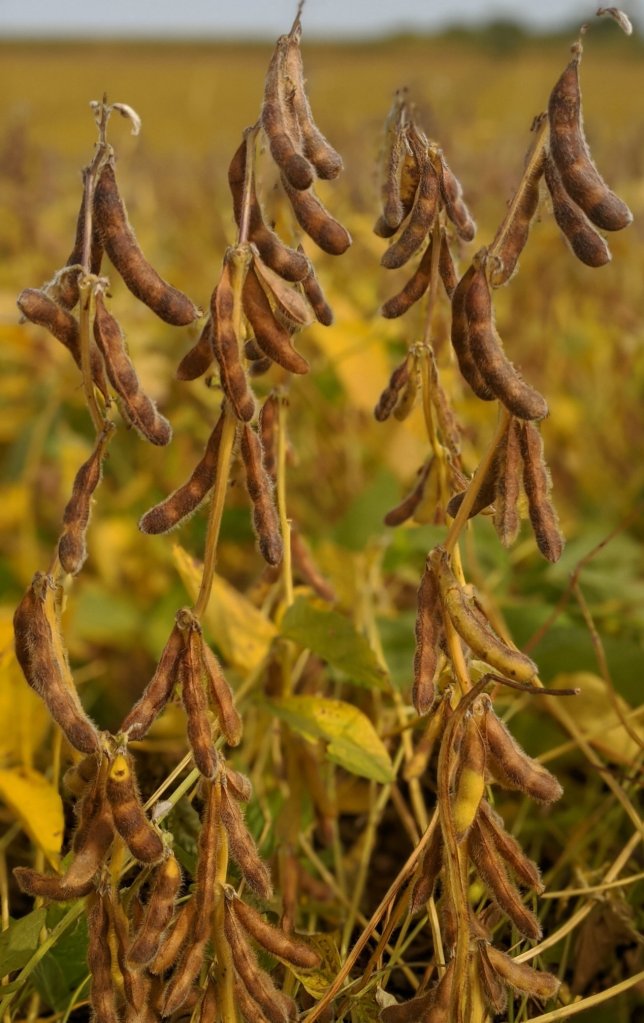| Upcoming Events: Sept. 22: Webinar: Garden Composting, 7 p.m., https://go.unl.edu/grobigredvirtual Sept. 29: N-Field Chat, 7 p.m., https://go.unl.edu/n-field-chat Sept. 29: Webinar: Preparing your garden for winter, 7 p.m., https://go.unl.edu/grobigredvirtual |

Soybeans: The past week I was mostly in soybean fields taking harvest notes for on-farm research or helping harvest plots. The non-irrigated yields have been better than anticipated for the beans just dying in fields; I can’t help but wonder what they could’ve been had there been rain in August! As noted last week, there’s a definite difference in varieties as to the number of 4-bean pods. Some varieties are loaded with pods and it’s not hard to find 4 bean pods. Others in our variety studies have a majority of 3 bean pods and it’s rare to see 4 bean ones. It will be interesting to see yields, and may be something to observe in varieties on your farms if you’re curious. Will also take a look at solar radiation data as several commented the smoke seems to be impacting drydown of irrigated soybeans.

Woolly Bear Caterpillars are noticeable in soybean fields as are stink bugs and loopers; however, woolly bears are also on the move from soybean fields to find green plant tissue elsewhere. In past years, it’s not uncommon to find them crossing roads. I had a couple of reports towards the end of last week of them demolishing garden plants and shrubs. They probably don’t need controlled in all cases and not all products are as effective on them. Bifenthrin is labeled to be effective on them and can be used on a variety of plants, so that may be one option if treatment is necessary.
Stalk Nitrate Test: A corn stalk nitrate test can provide an indication if the amount of nitrogen for the corn plants was low, high, or sufficient for that year. This test involves taking an 8” sample of the stalk. It should be taken 6” above the soil line and go to 14” above the soil surface. All leaf sheaths should be removed from the stalk. 15 samples should be collected 1-3 weeks after black layer from a one acre area that represents a larger area (same soil type, etc.). Sample other areas of the field with different soil types or management. Then place stalk samples into a paper bag (don’t use plastic) and ship the samples within one day or refrigerate until shipping. It’s important to take the sample from 6-14” above the soil line because all the research to create the test was done from that area of the stalks. Also note that situations like a good grain fill season, drought, or poor ear development can all impact the test providing lower or higher numbers. This test isn’t to be used to determine nitrogen rates. It just gives a ballpark over time regarding if too much, too little or sufficient nitrogen is available on a consistent basis over years in a field. If the test results over several years are consistently high (greater than 2000 ppm), it would suggest the grower could reduce nitrate rates without impacting yields. If too low, the grower could consider additional nitrogen or adjust nitrogen management within the field. You can read more about this test here: https://store.extension.iastate.edu/product/Use-of-the-End-of-Season-Corn-Stalk-Nitrate-Test-in-Iowa-Corn-Production. My colleague, Aaron Nygren, also created a short Twitter video here: https://twitter.com/ColfaxCountyExt/status/1305982739791966208?s=20.
Sensors and ET gages: A quick reminder to remove any sensors for irrigation scheduling and ET gages from your fields before harvest. In the midst of everything else, it can be easy to forget about them!
Fall Lawn Fertilization: Early September is one of the best times to fertilize Kentucky bluegrass and tall fescue. There’s still time to apply if it’s not yet been done. One application may be all that’s needed on older lawns (10 to 15 or more years). Use a fertilizer with at least a 50% slow release nitrogen source. Two fertilizer applications are recommended on younger lawns; one in late August/ early September and one about mid-October. Use a slow release nitrogen source on the first application and a fast release nitrogen source on the second one. Avoid fertilization after late October as plant uptake is low. This causes nutrients to leach away during winter or linger in soil until spring leading to early growth. More info: How to Fertilize Turfgrass This Fall.


































